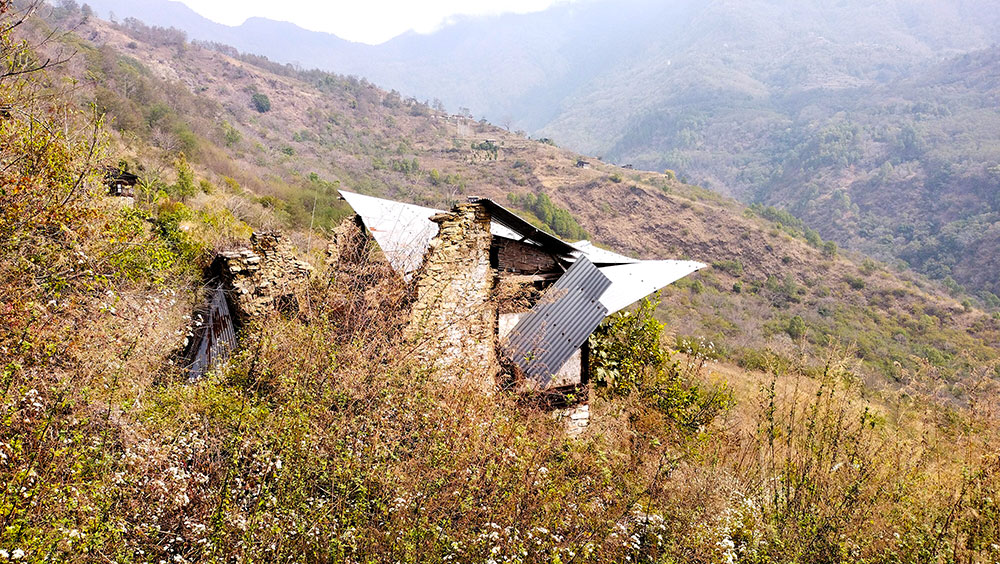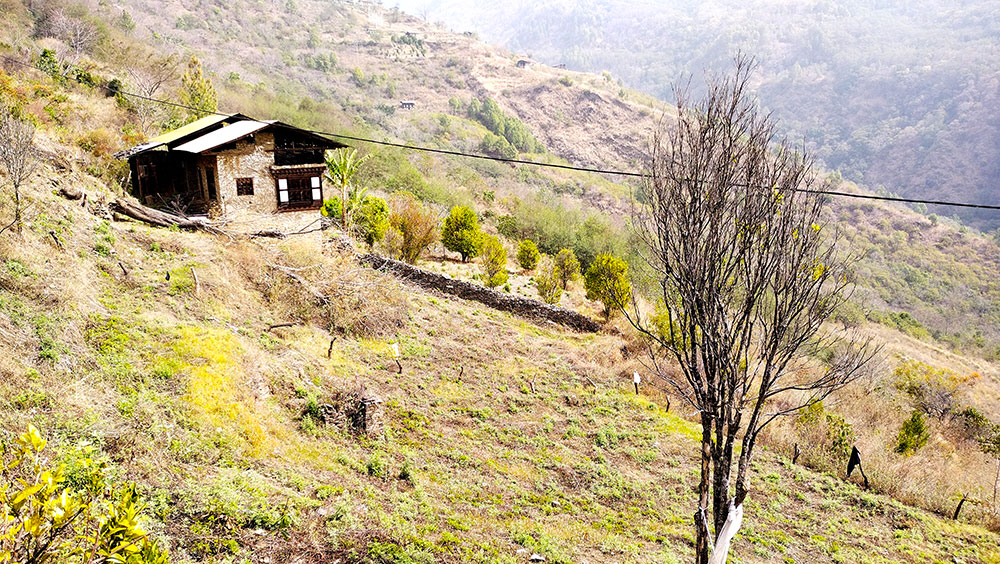Neten Dorji
Bartsham—An abandoned house stands at the edge of Jammu village in Bartsham gewog, Trashigang. Made of mud and stones, the roof of the house has already collapsed, while the rest is on the verge of caving in.
Creepers have invaded the half-open wooden windows. A rusted lock, which looked ready to break even with a slight touch, hangs on the door of the traditional house that was once a home of a prosperous farmer of the village.
This is one of the 166 empty houses (goongtongs) in the gewog today with some having abandoned for more than two decades now.
Another two-storey house above the farmroad towards Bartsham gewog had been abandoned for about 20 years.


There are more than 160 empty houses in the gewog today
Jammu village was once had strong community vitality, according to the remaining villagers.
“The once lively settlement has now turned into an uninhabitable place with houses covered in bushes, and frequented by wild animals,” said 87-year-old, Dhendrup, pointing towards Jammu village.
Before people started moving out of the village, there was a popular tshechu in Jammu village, held at Mani (Choeten) Ngangsampa. The popular festival was more than just a celebration as it served as a sign of strong community vitality in the village. However, now, the Jammu Tshechu had also disappeared.
According to locals, community members volunteer and donate in various forms, including monetarily, to conduct the tshechu every year, which used to keep this small and close-knit community together.
“We used to organise the festival in turns, during which we prepared everything – contributed rice, alcohol, cheese, butter, and provided labour. However, the rural-urban migration has weakened community vitality,” said Tenzin, who currently resides in Yangkhar but is originally from Jammu.
She explained that the village had become empty as older people moved away, along with their children who reside in urban areas and abroad.
“During the 1990s, all people used to go to Jammu Tshechu, sing and dance away the whole night, and celebrate,” said Cheten Zangmo, another villager.
Another elderly villager, Phuntsho, said that until two decades ago, the villages were full of people.
“The continuous migration of people from villages to urban areas is a sad reality. When you see a settlement from afar, it looks like a thriving place, but when you go near, you will see the houses lying in ruins with no one to care for them,” said Phuntsho.
From the GNH (Gross National Happiness) point of view, community social support encompasses volunteering or donating to individuals or communities, considered vital for community well-being.
Weaknesses in relationships and interactions within communities, such as limited social cohesion among family members and neighbours, as well as reduced participation in volunteering and donations, are indicators of diminished community vitality.
Bartsham Gup, Kelzang Dawa said villagers could not be blamed for leaving the villages. “Everyone has the right to choose the kind of life they want. Educated children stay in urban areas, and elderly parents go along with them, which leads to empty villages.”
He said that besides other impacts from rural-urban migration, most of the festivals were at risk of disappearing.
“They send small amounts whenever there is a festival in the village,” he said. “But sending money and being here in person are two different things. Anyone can send money and get the work done, but the bond that our community has is fading.”
Local leaders emphasise that in order for the gewog to experience further development, it is imperative for everyone to encourage the return of the people.
“Local governments alone can’t stop migration. But all three levels of government must work together and find a solution,” said a local leader.
Currently, every villager throughout Trashigang shares a similar narrative. Within most households, only elderly individuals remain, as many of the younger residents had left the village. Simultaneously, while dwellings teeter on the brink of collapse, the fields had turned fallow.
Meanwhile, Trashigang had 1,055 empty houses (goongtongs) in 2018. By 2023, this number had climbed to 1,469, representing a 4 percent increase. The latest statistic compiled by the dzongkhag reports that 17% of rural people have migrated to urban hubs resulting in 1,469 empty houses (goongtongs) in Trashigang.
With 181 empty houses, Thrimshing gewog recorded the highest goongtongs followed by 166 empty houses in Bartsham Gewog and 159 empty houses in Radhi Gewog.


